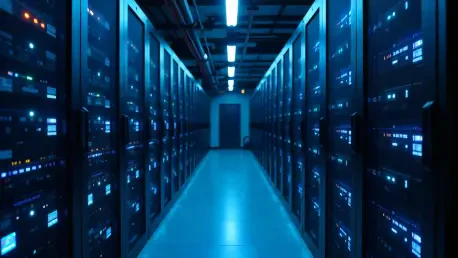The United States stands at a pivotal moment in the race for global technological supremacy, with artificial intelligence (AI) infrastructure emerging as a cornerstone of national strength, and as of 2025, the demand for robust data centers and advanced computing systems has never been higher. This surge, driven by an insatiable need for AI-driven solutions across industries, raises a critical question: can strategic government incentives, such as expanded tax credits, catalyze the rapid scaling of AI infrastructure to maintain a competitive edge? This report delves into the current state of the sector, explores proposals for policy support, and examines the challenges and opportunities shaping the future of AI development in the U.S.
The Current Landscape of AI Infrastructure in the U.S.
The AI infrastructure sector in the U.S. is experiencing unprecedented growth, fueled by the integration of machine learning and generative AI into everything from healthcare to defense. This expansion is not merely a trend but a strategic imperative, as dominance in AI technology directly correlates with economic and geopolitical influence. Major tech hubs are witnessing a boom in investments, with billions poured into building the backbone of AI capabilities, positioning the nation as a leader in innovation.
Key components of this ecosystem include data centers, energy-grid systems, and specialized AI servers, all of which are essential for powering large-scale models. Leading players like OpenAI are at the forefront, driving advancements and setting benchmarks for computational capacity. Their efforts highlight the scale required to meet growing demands, as well as the complexity of coordinating hardware, software, and energy resources to sustain operations.
However, current government policies, such as the CHIPS Act, fall short of addressing the full spectrum of AI infrastructure needs. While the act provides significant support for semiconductor manufacturing, it lacks provisions for other critical elements like energy systems or data center construction. This gap underscores the need for broader policy frameworks to ensure that the U.S. remains ahead in the global AI race.
OpenAI’s Proposal for Expanded Tax Credits
Broadening the Advanced Manufacturing Investment Credit (AMIC)
A notable push for policy reform comes from OpenAI, which has proposed extending the Advanced Manufacturing Investment Credit (AMIC) to cover a wider array of AI infrastructure components. Currently offering a 35% tax credit for semiconductor-related investments, AMIC could be expanded to include energy-grid elements, AI servers, and data centers under this proposal. Such a change aims to address the diverse needs of the sector beyond just chip production.
This broadening of tax incentives could significantly reduce capital costs for companies investing in AI infrastructure. By offsetting initial financial burdens, the expanded credit would mitigate early-stage risks, encouraging more private entities to commit resources to large-scale projects. The potential for accelerated deployment of critical facilities is a key argument in favor of this policy shift.
Moreover, lowering financial barriers through tax credits could stimulate innovation by allowing firms to allocate more funds toward research and development. This ripple effect might enhance the overall quality and efficiency of AI systems, strengthening the U.S. position in the global market. The proposal represents a strategic lever to align public policy with industry needs.
Financial Scale and Growth Projections
OpenAI’s vision for the future is ambitious, with projections indicating substantial funding increases in the coming years. The organization anticipates annual funding exceeding $20 billion as of now, with expectations of scaling to hundreds of billions by 2030. This trajectory reflects confidence in the transformative potential of AI and the infrastructure required to support it.
To achieve these goals, OpenAI has committed $1.4 trillion in capital over the next eight years, highlighting the immense financial stakes involved. Such a commitment underscores the urgency of policy support, as unlocking private capital through incentives like tax credits could be pivotal in meeting these investment targets. The scale of funding also signals a broader industry trend toward massive capital mobilization.
Looking ahead, the alignment of government incentives with private investment could create a multiplier effect, driving exponential growth in AI capabilities. Tax credits, if implemented effectively, might serve as a catalyst, enabling companies to scale operations faster than would otherwise be possible. This financial synergy is central to realizing long-term projections.
Challenges in Scaling AI Infrastructure
Scaling AI infrastructure is not without significant hurdles, chief among them being the high capital costs associated with building and maintaining advanced facilities. Data centers and energy systems require substantial upfront investments, often deterring smaller players from entering the market. This financial barrier poses a risk to widespread adoption and innovation.
Supply chain constraints further complicate the landscape, with shortages of critical materials like copper and rare earth minerals slowing progress. These resources are indispensable for constructing the hardware that powers AI systems, and global competition for them intensifies the challenge. Addressing these bottlenecks requires coordinated efforts to secure reliable supply lines.
Additionally, lengthy permitting processes and environmental reviews often delay projects, adding to costs and timelines. OpenAI has called for streamlined regulatory procedures to expedite development, alongside proposals for a strategic stockpile of essential materials. While these solutions hold promise, they must be balanced against market-driven risks, such as over-reliance on government intervention, which could distort competitive dynamics.
The Role of Government Policy in AI Development
The regulatory landscape for AI infrastructure remains a focal point, with the Biden administration’s CHIPS Act serving as a foundational policy. However, its narrow focus on semiconductor manufacturing leaves other critical areas unaddressed, limiting its impact on the broader AI ecosystem. This gap has sparked discussions about the need for more comprehensive support mechanisms.
OpenAI advocates for targeted policy adjustments, including tax credits and permitting reforms, while explicitly rejecting direct financial bailouts. This nuanced stance reflects a desire for a supportive environment without government overreach in market decisions. The balance between public assistance and private independence is a recurring theme in shaping effective collaboration.
The broader implications of public-private partnerships are significant for maintaining U.S. leadership in AI technology. Strategic government involvement can help address systemic challenges, but it must be carefully calibrated to avoid stifling innovation or creating dependency. This delicate interplay will likely define the trajectory of AI policy in the coming years.
Future Outlook for AI Infrastructure Growth
Emerging trends point to a sustained increase in demand for large-scale data centers as AI applications proliferate across sectors. Industries ranging from finance to logistics are integrating AI at an accelerated pace, necessitating robust infrastructure to handle vast computational loads. This trend signals a long-term shift toward AI-centric systems.
Potential disruptors, such as global supply chain volatility and evolving regulatory frameworks, could impact growth trajectories. At the same time, opportunities for innovation in energy-efficient infrastructure offer a pathway to mitigate some challenges. Developing sustainable solutions will be crucial for balancing expansion with environmental considerations.
Economic conditions and policy decisions will also play a decisive role in shaping the sector’s future. If supportive measures like expanded tax credits materialize, they could propel investments to new heights. Conversely, delays or restrictive policies might hinder progress, underscoring the importance of timely and adaptive governance in this dynamic field.
Conclusion: Balancing Support and Independence in AI Growth
Reflecting on the insights gathered, it becomes clear that tax credits like the expanded AMIC have the potential to act as powerful catalysts for AI infrastructure development. They offer a mechanism to alleviate financial pressures and address systemic bottlenecks, fostering an environment where private capital can thrive. The discussions around OpenAI’s proposals illuminate a path forward that balances policy support with market autonomy.
Looking ahead, policymakers are encouraged to prioritize streamlined regulations and strategic incentives to sustain momentum in the sector. Industry stakeholders, on the other hand, need to focus on resilience, investing in alternative supply chains and sustainable technologies to navigate uncertainties. These actionable steps promise to fortify the U.S. position in the global AI landscape.
Ultimately, the collaboration between public and private entities emerges as a linchpin for success, with the potential to unlock unprecedented growth. By fostering innovation through targeted support while preserving competitive dynamics, the foundation is laid for a future where AI infrastructure not only meets current demands but also anticipates tomorrow’s challenges.









